|
December 1958 Popular Electronics
 Table
of Contents Table
of Contents
Wax nostalgic about and learn from the history of early electronics. See articles
from
Popular Electronics,
published October 1954 - April 1985. All copyrights are hereby acknowledged.
|
Who cares about television
antennas these days, you're probably asking? Many people might care soon. The December
2012 edition of the IEEE's Spectrum magazine had an article titled, "TV's Future: The Broadcast Empire Strikes Back." According to
author Lynn Claudy, the Advanced Television Systems Committee (ATSC) is working on a standard
called Mobile
DTV (MDTV) in the United States. MDVT enables broadcast stations to deliver
programming to some cellphones, laptops, tablets and to moving television screens
in cars, trains, and buses. Furthermore, a scheme to enable on-demand programming,
user feedback (voting, polls, quizzes, games), and other advanced features is under
investigation in research labs and field trials. Local businesses welcome a rebirth
of regional over-the-air-broadcasts (OTA) to provide pricing competition with dominant
cable TV. So, although this article was originally written in 1958 when only OTA
broadcasts existed, it may soon be a valuable resource for you and your neighbors
when deciding on which antenna to put up on the roof. Antenna rotator article are
forthcoming.
See the TV antenna selection articles in the
December 1958,
March
1972, and April 1973 issues of Popular Electronics.
Choosing Your TV Antenna

Folded dipole with reflector. One antenna for channels 2 to 6,
another for channels 7 to 13; each necessary if both high and low channels are to
be received.

Conical antenna with conical reflectors. Similar to previously
mentioned conical antenna but slightly more directional.

Conical or fan-type antenna. Model shown has high-channel stubs.
A very popular antenna, with moderate gain and directivity.
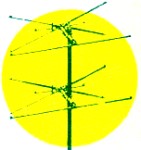
Stacked conical with straight reflectors. A moderate-gain broadband
antenna for use in semi-fringe areas.

Vee-beam antenna. Low gain on Channels 2 to 6, fair on 7 to 13.
Each of four elements should be at least 45" long; if not, reception on low channels
will suffer, and an antenna should be used on high channels only.

Stacked in-line antenna. Effective moderate gain assembly with
good response over all of the various channels.
By Rudolf F. Graf
The best TV antenna made isn't good enough for your set unless it's matched to
the needs of your location. Distance from the transmitter is the biggest factor
affecting TV reception, but local terrain, adjacent buildings, or mountains can
cause the signal to come in strong or fade out altogether regardless of distance.
The only way to insure a good signal is to choose the right antenna for your location
and for the channels used most frequently.
Television reception areas are broadly classified by their distance from the
station:
• Primary or local area (up to 35 miles) • Semi-fringe area (up to 50 miles)
• Fringe area (up to 75 miles) • Deep fringe area (up to 200 miles)
By the time the signal reaches the receiver location, it may be quite weak. Therefore
it's important to have the best possible antenna installation. Height, type and
direction are all important factors.
Adjacent-channel interference, which is a frequent troublemaker, seen as weaving
diagonal lines, is caused by a signal from the next higher or next lower station.
If you are tuned to Channel 11, for example, a strong station on Channel 10 or 12
may cause adjacent-channel interference.
On the other hand, co-channel interference (vertical "windshield wiper" or horizontal
"Venetian blind" black bars) is caused by a station operating on the same channel
as the one we are trying to receive. This trouble usually crops up if the TV set
is about half way between two stations on the same channel.
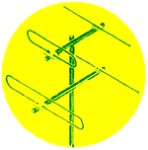
High-low antenna. Individually adjustable dipoles with reflectors.
Good all-around antenna for primary signal areas.
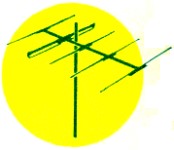
Five-element Yagi. High-gain directional single-channel antenna.
Separate antenna required for each channel.
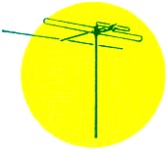
In-line antenna. Fairly directional all-around antenna with good
gain.
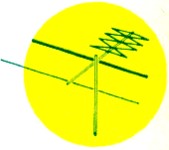
Helical Yagi. All-channel antenna with moderate. Performance
better on higher channels than on low.
Both of these types of interference can be eliminated with sharply directional
antennas. In the case of adjacent-channel interference, a single-channel Yagi with
a filter at the receiver may work wonders.
No amount of receiver adjustment will banish a ghost caused by reflections from
buildings, mountains or other objects. Antenna re-orientation or replacement are
the only certain cures.
The roof or outdoor antenna is easily the best and most efficient type. It is
desirable in primary areas and absolutely essential in fringe areas. It may be a
single-channel, selective-channel or all-channel job. About 50 different designs
are available today but selection of any particular one depends greatly on the terrain.
Antenna Dictionary
Boom (Crossarm) - The horizontal bar or tube which serves as mechanical support
for all the antenna elements.
Dipole - The simplest of all TV antennas, consisting of two electrically unconnected
rods or tubes arranged end to end. Transmission line is connected in center.
Directivity - Ability of an antenna to select signals from one or several desired
directions. Antennas may be "unidirectional" - receive signals from one direction
only, or "bidirectional" - receive signals from opposite directions but not from
the sides, or "omnidirectional" - receive signals from any direction.
Director - A parasitic element placed in front of the driven element for increased
gain and directivity.
Driven Element - That element (or elements) which "collects" the TV signal. It
is connected to the TV lead-in.
Element - Everyone of the working parts of an antenna is called an element. It
may be either driven or parasitic.
Front-to-Back Ratio - A numerical ratio showing how much more signal is received
from the front of the antenna than from the back.
Gain - A figure expressed in decibels (db) which indicates the signal gain of
a particular antenna type over that of a simple dipole.
Mast - The heavy vertical tubing which supports the antenna. The crossarm is
usually bolted to the mast.
Parasitic Element - An element or elements not directly connected to the driven
element. Parasitic elements act as directors and reflectors for increased signal
strength and directivity.
Reflector - A parasitic element or elements placed behind the driven element
for increased gain and directivity.
Stacking - Two or more antennas joined together electrically with stacking bars
or a stacking harness.
Twin Lead - The transmission line which carries the signal captured by the TV
antenna to the TV receiver.
Posted August 19, 2021
(updated from original post on 3/21/2013)
|



















